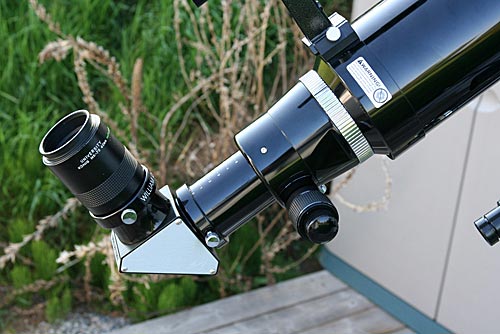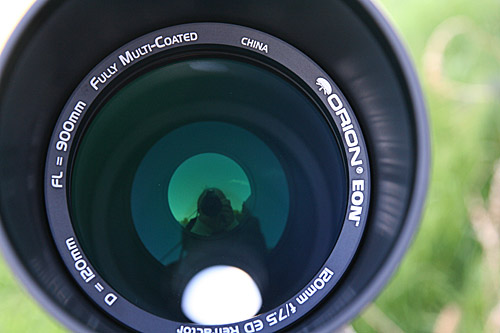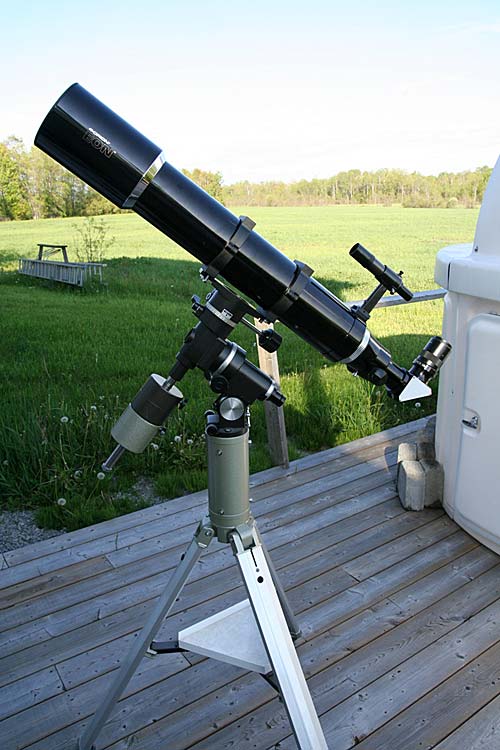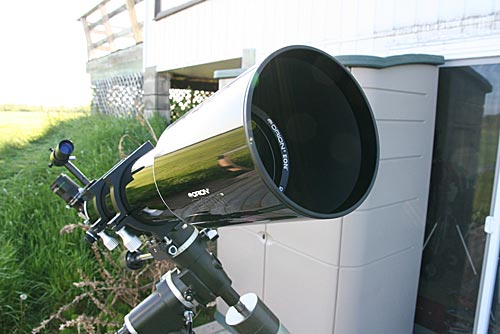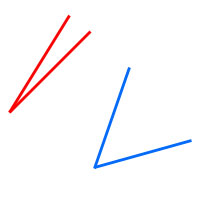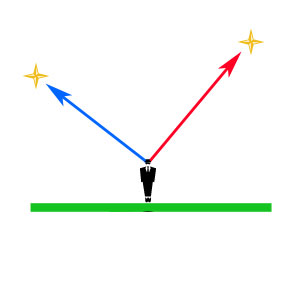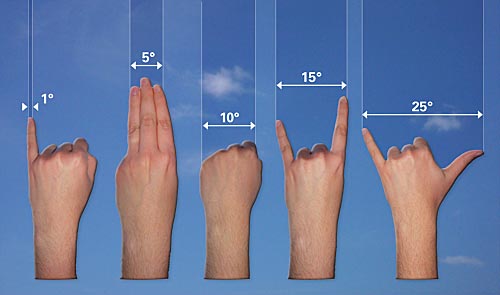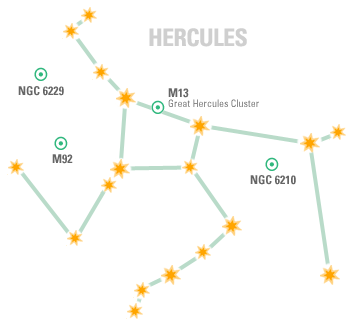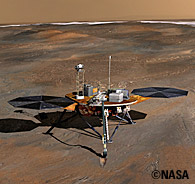 |
||||||||||||||||||||||||||||||||||||||||||||||||||||||||||||||||||||||||||||||||||||||||||||
|
If you have trouble viewing this newsletter, click here. Welcome again to our monthly newsletter with features on exciting celestial events, product reviews, tips & tricks, and a monthly sky calendar. We hope you enjoy it!
Five years ago, Orion® released their first ED refractor—an 80mm f/7.5—at an unprecedented low price. I was one of the earliest purchasers of this scope and continue to be amazed at the quality of its images. The 80mm was soon followed by a 100mm f/9, which I also ordered the first day it appeared on Orion®’s web site. There followed a third ED refractor—a 120mm f/7.5—which I decided to skip because I feared its short focal ratio would produce too much chromatic aberration. Recently Orion® has announced a new series of ED refractors with vastly improved mechanical construction. Not that I had any complaints about my 80ED and 100ED, but there was room for improvement. I was recently loaned one of Orion®’s new 120mm f/7.5 EON apochromats for testing. The first big surprise was that it came packed in a very solid fitted foam lined carrying case with cutouts for the optical tube assembly itself, several eyepieces, and a 2-inch diagonal. The tube assembly is now finished in a rich glossy black with a sliding dew shield and fitted metal dew cap at one end and, at the other, a heavy duty rotatable dual-speed Crayford focuser.
In between is a set of felt lined tube rings attached to a standard Vixen/Synta dovetail and a standard dovetail finder shoe—for once located properly on the tube itself, not back on the focuser where it interferes with the diagonal and eyepiece. The entire assembly is clearly heavy-duty and business-like but also, thanks to its precision machining and glossy finish, downright beautiful! The huge objective has impeccable coatings, making it almost invisible when you look in the dew shield.
For testing purposes, I mounted the scope on my trusty Vixen Super Polaris mount, a very handsome and solid combination. Like the other scopes in this series, the EON 120 does not come with finder, diagonal, or eyepieces, so I attached an Orion® 6x30 finder, a 2-inch William Optic dielectric diagonal, and my usual assortment of eyepieces.
Planetary parade June offered a fine variety of planets to test this scope’s mettle. As evening fell, Saturn was a lovely sight in the west; I was able to comfortably use 225x. Because of the current narrowness of the rings, Cassini’s Division was only suspected, but the detail of ring and planet and their shadows was beautifully clear. I stayed up late to observe Jupiter at its highest, and was treated to a fine view of the giant planet. The North Equatorial Belt was an intense chocolate brown, while the South Equatorial Belt was wide, orange-colored, and filled with intricate detail. By the time the Great Red Spot rolled around into view, the telescope’s objective had begun to dew up, reducing the contrast of the image. I could see the lighter Red Spot Hollow clearly, but could not quite make out the Red Spot itself. A few nights later with my 11-inch Schmidt-Cassegrain I was able to see little more detail than with the 120mm EON; Jupiter is just too tough a target when it is so low in the sky for an observer located at 45° N latitude! A moon a few days short of full provided a different sort of challenge for the EON. The huge difference in contrast between the sunlit lunar highlands and the deep shadows of craters is an acid test for a refractor. Any shortfall in color correction will be brutally revealed by color fringing due to chromatic aberration. I had doubts whether a 120mm f/7.5 ED doublet could meet such a challenge, but the EON put my doubts to rest. The moon’s surface was cleanly rendered in tones of white, black, and grey, with not a hint of color fringing around the brightest highlights or within the deepest shadows: a stunningly good performance! Double stars The present popularity of refractors has led amateur astronomers to rediscover the beauties of double and multiple stars, a popular target for an earlier generation of amateur astronomers. Although beautiful in any telescope, double stars are a special treat in a refractor thanks to the telescope’s clean uncluttered images. I turned first to Algieba (Gamma Leonis), a beautiful golden pair at 150x. Next was my all-time favorite multiple star, Epsilon Lyrae, the Double Double. At first glance a wide pair, closer examination reveals that each of the two stars is in itself a really close binary. At 225x all four stars were cleanly visible. The biggest challenge of the night was Porrima (Gamma Virginis). Most of the time this is quite an easy pair, but for the last few years the two component stars have been extremely close together and inseparable in even the largest telescopes. At 225x, I was just able to see this star as a “peanut” shape, its two components merging along their central zone. The separation of the two components is only 1.1 arcseconds at present, so detecting any separation was a triumph for this scope. Deep sky wonders There is a popular myth that refractors only excel at lunar and planetary observing, and that deep sky observing is the property of large Newtonians—not so! One of my most memorable deep sky observing sessions years ago was with a Celestron 150mm f/8 achromatic refractor, whose contrast and light throughput yielded views I’d expect only from a larger telescope. So I was looking forward to trying out the EON 120mm on some favorite deep sky targets. First up was my old friend M57, the Ring Nebula in Lyra. At 56x it was a perfect smoke ring. Next was one of my favorite galaxies, M104 in Virgo, the Sombrero. At 56x it showed a clear hint of its central dark lane, quite remarkable in such a small aperture. M13, the great globular cluster in Hercules, was nicely resolved into stars at 82x. The Dumbbell Nebula in Vulpecula was easy to see without a filter, but really jumped out from the background with an OIII filter in place. The Veil Nebula was invisible without the filter, but both halves were easy using the OIII filter at 22x. The two halves wouldn’t quite fit in my 40mm eyepiece’s 3.1 degree field, but it was easy to sweep slightly back and forth to catch the whole nebula. This is a situation where the relatively short focal length of this scope really pays off.
Summary The Orion® EON 120mm refractor proved to be an outstanding performer, optically and mechanically, on a wide variety of targets. The only problem I encountered was a little bit of slippage of the Crayford focuser under the weight of the 2” diagonal and eyepieces when pointing high overhead, but a slight tightening of a setscrew put that right. This is an extremely impressive telescope in every respect, showing fine optics, mechanical perfection, and sheer physical beauty. This telescope sets a new standard for performance and price. Geoff Gaherty
If you're an amateur astronomer without any formal scientific training, some of the math involved might look like magic spells. Let's face it, you can be interested in science and nature even if you weren't good at math in school. You might even be one of those people who is perfectly capable of mathematical thinking as long as you have a context for it. Read on for the first installment of a series of articles designed to help you catch up on a few morsels that will vastly help your understanding of astronomy. Draw two straight lines that are not parallel to each other. Make one end of one line touch one end of the other line, in any orientation. You have just drawn an angle. Here are two examples:
The red lines form a smaller angle than the blue lines do. This has nothing to do with the length of the lines or how far apart the 'ends' of the lines are. Even if you were to chop off the free ends of any or all of those lines, the angles between each pair of lines would remain the same. All that matters is the direction of the two lines relative to each other. If you're standing on Earth and you can see two stars in the sky, you can imagine that two lines meet at your location and extend out towards those stars.
The angle between those two lines is a convenient way to express how far apart two stars appear to be in the sky. Again, forget about the length of the lines or the distance to either of those stars. Imagine that the sky is a dome over your head, or that the Earth is sitting at the centre of a sphere and the stars are painted all over the inside of it. (They're really far away, of course, and one of them is likely to be much farther away than the other, but for the purposes of measuring their separation on the sky, we don't need to know the true distances to them.) We need some objective way of measuring this angle, something that can be communicated to someone else or written down for future reference. Just as you use miles or kilometers to measure distance between places, you need a unit of measurement to measure angles. The most common one is the degree. Draw a circle and mark the exact centre. You'll notice that if you draw two lines that cut a wedge into the circle, starting at the middle and going to the edge as if you were cutting a slice of pie, there will be an angle between those two lines.
If you were to cut three hundred and sixty equal slices from this pie, each slice would have an angle of one degree—again, regardless of how big the pie is; similarly, any size of pie can be cut into four equal pieces, and the pieces are called quarters. Now, whenever you look at two stars and you want to know how far apart they are on your sky, you can measure the angle between them and say how many degrees it is. Imagine that the two stars are sitting on a hoop, and you're at the centre of the hoop. Measuring their separation in degrees is like measuring how far around the circle you have to go to get from one to the other. If you need more precise measurements, each degree can be divided into sixty arcminutes, and each arcminute can be divided into sixty arcseconds. Now, when you see the Moon setting, you can tell someone how far above the horizon it is. I've heard people try to measure such things in inches. If you hold a ruler up and look at the sky, an inch will cover more sky if you have short arms, and less sky if you have long arms! This doesn't work. A good estimate is that your hand spread wide at arm's length is about twenty-five degrees from thumb-tip to pinky-finger-tip. If you have short arms you probably also have smaller hands, so this works better than a ruler.
Your pinky finger held up at arm's length is about one degree wide. If you know that a galaxy is a certain number of arcminutes across, you can decide whether you want to use high or low magnification to look at it. Next month we'll cover some more advanced applications of this geometry, like latitude, longitude, and celestial coordinates. Brenda Shaw
You may remember that in August of 2006, the International Astronomical Union (IAU) caused quite a stir by reclassifying Pluto as a dwarf planet. This was mostly due to the discovery of a host of large, asteroid-like objects beyond the orbit of Pluto. One of these, now called Eris, was actually larger than Pluto! Thus, to avoid a huge increase in the number of planets (as was the case in the mid 1800’s)1, the new category of dwarf planets was created. On June 11, 2008, the IAU decided to designate Pluto as a “plutoid”. As well, any other dwarf planet candidate that was further from the Sun than Neptune would also be a plutoid. That means Eris (further from the Sun than Neptune) is a plutoid but Ceres (between Mars and Jupiter) is not. What about some of the other bodies orbiting the Sun beyond Neptune in the so-called Kuiper belt? Well, if any such object is bright enough (absolute magnitude brighter than H = +1)2, it becomes a plutoid, at least temporarily. If further studies indicate the object is not massive enough, it loses its “plutoid” status. In a nutshell, then, a plutoid appears to be a dwarf planet that orbits the Sun beyond Neptune. Why then come up with a new term? Probably because the definition of a plutoid is not as nebulous as the definition of a dwarf planet. Here then is the current situation:
Is this the end of the story? Hmmm.... Stay tuned! Notes:
Herb Koller
The fifth largest constellation in the sky, Hercules is perhaps most famous because of the Great Hercules Cluster, M13, perhaps the most prominent of globulars visible to northern hemisphere observers.
The Great Hercules Cluster is visible to the naked eye at dark sites. The glob is about 14 billion years old and contains more than a million suns. Because of its proximity to M13, M92 is often overlooked even though it's one of the brighter clusters available to northern viewers. One of Johann Elert Bode's discoveries in 1777, it was rediscovered by Charles Messier in 1781 and has been clocked speeding toward us at 112 km/sec. NGC 6229 is another globular cluster that's worth a look. Mistaken for a nebula by Herschel in 1787, it was revealed to be a "very crowded cluster" in the mid 1800s. NGC 6210 is a planetary nebula, a sun not unlike our own in the final stages of its life. It has a very high surface brightness and is a good target for high magnification. Sean O'Dwyer
Name: Christopher J. Plasch
Picture Details:
PRIZES AND RULES: We would like to invite all Starry Night® users to send their quality astronomy photographs to be considered for use in our monthly newsletter.
Please read the following guidelines and see the submission e-mail address below.
|
JUL 2008
|
|||||||||||||||||||||||||||||||||||||||||||||||||||||||||||||||||||||||||||||||||||||||||||
 |
||||||||||||||||||||||||||||||||||||||||||||||||||||||||||||||||||||||||||||||||||||||||||||
|
|
||||||||||||||||||||||||||||||||||||||||||||||||||||||||||||||||||||||||||||||||||||||||||||
You have received this e-mail as a trial user of Starry Night® Digital Download
or as a registrant at starrynight.com. To unsubscribe, click here.
